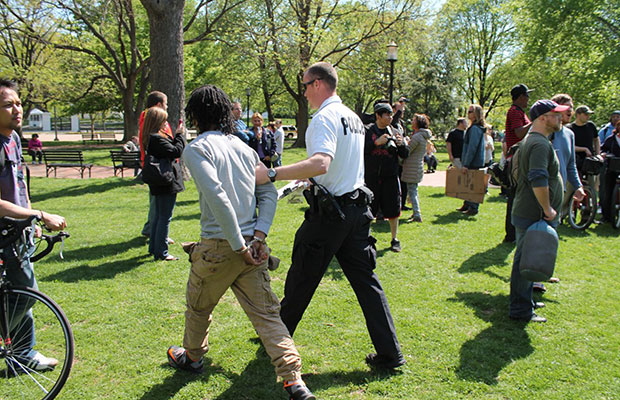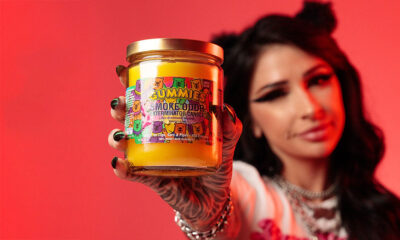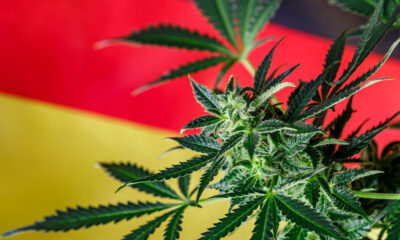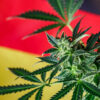
Legal
The Racial Divide – Discriminatory Policing in the Cannabis Industry
Brionne Corbray’s friends warned him against opening a dispensary. The 50-year-old, Seattle-area native had never sold cannabis before, but while he was making a documentary about Washington’s medical marijuana market for a college class, he realized that the booming industry could help him support his family.
“It seemed like everyone was allowed to participate in the marijuana industry to make a living,” says Cordray. “The black people I knew were scared to get involved, but I said, ‘What’s there to be scared of, they’re giving out licenses!’”
So, Corbray, a black man who prides himself on his entrepreneurial spirit, got his licenses and permits. He opened up a shop called the GAME Collective in White Center, an unincorporated city just outside of Seattle that has a large black and Latino population.
“People were coming in to my dispensary and thanking me, even older white people in their eighties, because they said before they had to go to seedy places and now they didn’t,” said Cordray. “Everything was going fine, and then I went to work one morning and the feds came in firing.”
The DEA raided his collective on November 15, 2011. Corbray says the agents shouted racial epithets at him while they searched his business. They told him they could do whatever they wanted to him because they were the federal government. In court and in the papers, the DEA accused Corbray of trafficking drugs across state lines to a gang in Chicago and of keeping a gun in the store. They seized his car and his cash.
The DEA’s arguments fell apart in court — as Corbray had never owned a gun, never even heard of the Chicago gang and had never trafficked drugs. He walked away on probation after his over-worked public defender encouraged him to take a plea deal. Still, Corbray remains unable to safely reenter the industry and struggles to find employment with a felony on his record and his reputation in the city tainted.
“It was after my case that I realized the marijuana industry is a white man’s game and the government is making sure that it stays a white man’s game,” says Corbray. “If I was white, they would have never done that to me.”
There were at least four other dispensaries near Corbray’s in White Center owned by white men, but only one other was raided because the owner had previously been a cocaine dealer.
Corbray’s story is about federal prosecution prior to Washington’s cannabis regulation initiative in 2012. Washington groups advocating for legalization — as well as groups in Colorado, Oregon and Alaska — argued that ending prohibition on adult-use cannabis would reform a criminal justice system that overburdens individuals and communities of color and would lead to less cases like Corbray’s. And yet, new data on the impact of legalization illustrates that discrimination remains rampant, even though overall arrests are down. While the smoke may be dissipating, the fire of racial policing continues to burn.
The Results of Regulation
The racism institutionalized within the policing strategies of the War on Drugs has been well documented and it inspired much of the support behind the passage of adult-use cannabis legalization initiatives in Colorado and Washington in 2012. These initiatives received endorsements from groups such as the NAACP, the National Latino Officers Association and the Blacks in Law Enforcement of America, among others, because of legalization’s anticipated ability to reduce the number of people of color arrested for cannabis offenses.
Black people are about as likely to use cannabis as white people, yet black people are on average 3.73 times more likely to be arrested for marijuana possession across the nation, according data from the American Civil Liberties Union.
Since voting for state regulations on marijuana, Colorado and Washington have seen overall cannabis arrest rates drop dramatically, as legal cannabis possession for adults is now up to one ounce. However, a recent study from the Drug Policy Alliance (DPA) found that the racial disparities of arrests in Colorado between 2010 and 2015 had not changed.
The study found that while total cannabis-related charges were down in Colorado by 80 percent, the higher rate at which black people were arrested stayed exactly the same. In 2010, black people were 2.4 times more likely than white people to be charged and remained 2.4 times more likely to be charged in 2014.
Jon Gettman, author of the DPA study and a criminal justice professor at Shenandoah University, was not surprised by his results.
“The fact that arrest rates for blacks are several magnitudes higher is a nationwide phenomenon,” says Gettman, who is also an advocate for cannabis law reform and led NORML for eight years in the 1980s. “It takes place in the north and the south and in places that have decriminalized and where you have black mayors and black police chiefs. Legalization doesn’t change that.”
But, to say disparities persist is not to deny that adult-use cannabis legalization has been beneficial to black communities, says Art Way, the Colorado Director of the DPA.
“Black individuals are no longer being pestered or sent to court for possession of minor amounts of marijuana and are no longer dealing with the collateral consequences of a guilty charge,” says Way. “There was a disproportionate impact on communities of color before, so there’s a disproportionate benefit after.”
The state of Colorado charged 774 less black people with a cannabis-related crime in 2014 than in 2010, according to Gettman’s research. Thanks to cannabis regulation, that’s 774 people who avoided the trauma of discriminatory policing that Brionne Corbray continues to cope with. Today, after battling depression for years after his case, Corbray is a changed man.
“I don’t want to live in this country anymore,” he says.
Legalization’s Steps Backward
In the states with cannabis regulation, one new area of focus for police in drug law enforcement is ticketing people who are consuming cannabis publicly. In the early data from Seattle, for example, police have begun issuing a disproportionate amount of public consumption tickets to people of color.
Seattle police reported in July that they issued 27 percent of their public consumption tickets to black people, even though black people make up about 8 percent of the city’s population, according to the U.S. Census. In the first half of 2014, over 36 percent of the public consumption tickets went to black men. Most of the tickets were issued downtown and in public parks.
Douglas Hiatt is a white man who has worked as a public defender and private lawyer for cannabis offenses in Washington for 25 years. He lives in downtown Seattle, where he says he has witnessed blatant racism in terms of police tickets for public consumption.
“I see these city cops targeting black people. It’s just that simple,” he says. “I’ve walked around smoking a joint for 10 years downtown and I’ve never gotten so much as a look. The people that the cops are ticketing are black – period.”
The issue of disproportionate public consumption ticketing complicates the often-voiced explanation for why black people are more likely to be charged with a marijuana-related crime — that communities of color tend to be poorer and have more crime, so they tend to see a higher police presence, and therefore black people just have more interactions with the police.
While heavier police presences in communities of color is a factor, the distribution of the police presence doesn’t explain why — in Seattle’s integrated spaces of public streets and public parks, such as the downtown area — black people continue to see higher levels of ticketing.
“The way that we police and the racist nature of the enforcement of drug laws guarantees that, even with marijuana regulation, the drug laws will be enforced against black people more,” says Hiatt.
He added that in his 25 years of experience as a cannabis defense lawyer, black men who are arrested are much more likely to see longer sentences, harsher plea deals and stricter probations.
Beyond public consumption ticketing, cultivation arrests have also begun to disproportionately target black people since Washington regulated cannabis in 2012.
In 2010, cultivation charges were the only area in marijuana policing where black people were charged with the crime at a rate proportional to white people, according to DPA research. But by 2013, that number had shot up and black people comprised over 15 percent of cultivation arrests, and only 3.9 percent of the population. Experts can make educated guesses why.
“It’s probably an issue of landowners and landlords making sure people weren’t growing marijuana in places where they didn’t own property,” says Way. “If you don’t own property or you don’t get your landlord’s permission, you can’t take advantage of the cultivation perks of Amendment 64.”
Because people of color are twice as likely as white people to rent property rather than own, according to data from the Joint Center for Housing Studies at Harvard University, the imbalance persists. However, Way thinks that as people begin to familiarize themselves with the nuances of Washington’s new cannabis laws, the cultivation arrests may return to neutral ground. In 2014, the percentage of black people charged with illegal marijuana cultivation had already begun to drop again, down to 9.2 percent.
Finally, cannabis legalization had the effect of increasing law enforcement’s focus on combating driving under the influence of marijuana — something that may specifically target young people of color.
Washington and Colorado have both instituted scientifically questionable laws that make it illegal to drive with a blood level containing more than 5 nanograms of THC per milliliter. THC lingers in the bloodstream long after impairment and drivers under 21 are being held to the same zero tolerance policy with cannabis as with alcohol. Those who are more likely to be pulled over — people of color — are bearing the brunt of the convoluted DUI laws.
While data is unavailable, Hiatt says he believes Washington will see DUI rates for people of color skyrocket in the coming years.
“The DUI laws allow police to target people of color and kids,” says Hiatt. “I would argue Initiative 502 was a horribly flawed law because it increased the focused on kids and kids of color.”
In Mesa County, Colorado’s western-most county that includes the city of Grand Junction along the main highway to Denver, cannabis charges against black people are the highest in the state and they hardly dropped after legalization.
“Black people always know to be careful driving through Grand Junction,” says Way. “That’s been the police culture there for 20 years and they’re still pulling black people over trying to catch drugs coming from California.”
In essence, state-sanctioned cannabis legalization has allowed local police to continue operating as usual, just with new and albeit more narrow areas to prosecute.
Possible Solutions
As the Black Lives Matter movement pushes racial issues with the American criminal justice system to the forefront of the nation’s psyche and calls for solutions to the endemic problem, no silver bullet has emerged. But most agree the fundamental role the police play in our current system needs to be reformed.
“Discriminatory policing is an issue of police culture and custom,” says Way. “There’s only so much that policy and law can do to change culture and custom. I think in general what would help the situation is to help to change what police do on a day-to-day basis. Instead of police going out to get a certain number of arrest, let’s put police on the front lines of providing services in communities, like diversion programs prior to an arrest, so police direct people to mental health or drug treatment services.”
The community policing approach can also be paired with, as Gettman advocates, “actual marijuana legalization,” where police have less to stop, search and arrest citizens for and therefore less areas wherein they can discriminate.
“At some point marijuana is going to be treated like alcohol and tobacco and there will still be arrests like drinking in public or selling tobacco to minors and open container laws,” says Gettman. “But I think if we get more and more normalized with the laws, the racial disparities will diminish.”
As Brionne Corbray’s arrest reveals, there are only so many steps forward a state can take when the federal drug enforcement policies remain unreformed. And as long as the federal government classifies cannabis as a Schedule I drug, states are actually incentivized to protect their legal marijuana industries with the strictest possible regulation because the Department of Justice has stated they will actively pursue the prosecution of cannabis offenses in states whose laws they deem too permissive.
“I was never anti-government until the DEA came after me,” says Corbray. “But now, I don’t trust the federal government and I had to accept everything they did to me or go to prison. There was a time when I used to love America. I used to think this was a land of equality and I used to be a happy person, but a lot of that happiness was naiveté.”
Now, Corbray is a real estate agent to make ends meet and he develops exercise equipment in his free time to keep his entrepreneurial side appeased. He says his depression is improving. Meanwhile, the cannabis industry grows faster than any other industry in the country and Corbray has been locked out of the room, forced only to watch the money grow through a window.
Published in issue 18 of Cannabis Now. ON SALE NOW! Click here to purchase.

























